- ubuntu12.04环境下使用kvm ioctl接口实现最简单的虚拟机
- Ubuntu 通过无线网络安装Ubuntu Server启动系统后连接无线网络的方法
- 在Ubuntu上搭建网桥的方法
- ubuntu 虚拟机上网方式及相关配置详解
CFSDN坚持开源创造价值,我们致力于搭建一个资源共享平台,让每一个IT人在这里找到属于你的精彩世界.
这篇CFSDN的博客文章SpringBoot与SpringMVC中参数传递的原理解析由作者收集整理,如果你对这篇文章有兴趣,记得点赞哟.
HandlerMapping中找到能处理请求的Handler(Controller,method()) 为当前Handler找一个适配器HandlerAdapter:RequestMappingHandlerAdapter 。

1.HandlerAdapter 。

0-支持方法上标注@RequestMapping 1-支持函数式编程的 xxxx 。
2.执行目标方法 。


3.参数解析器:确定要执行的目标方法每一个参数的值是什么 。
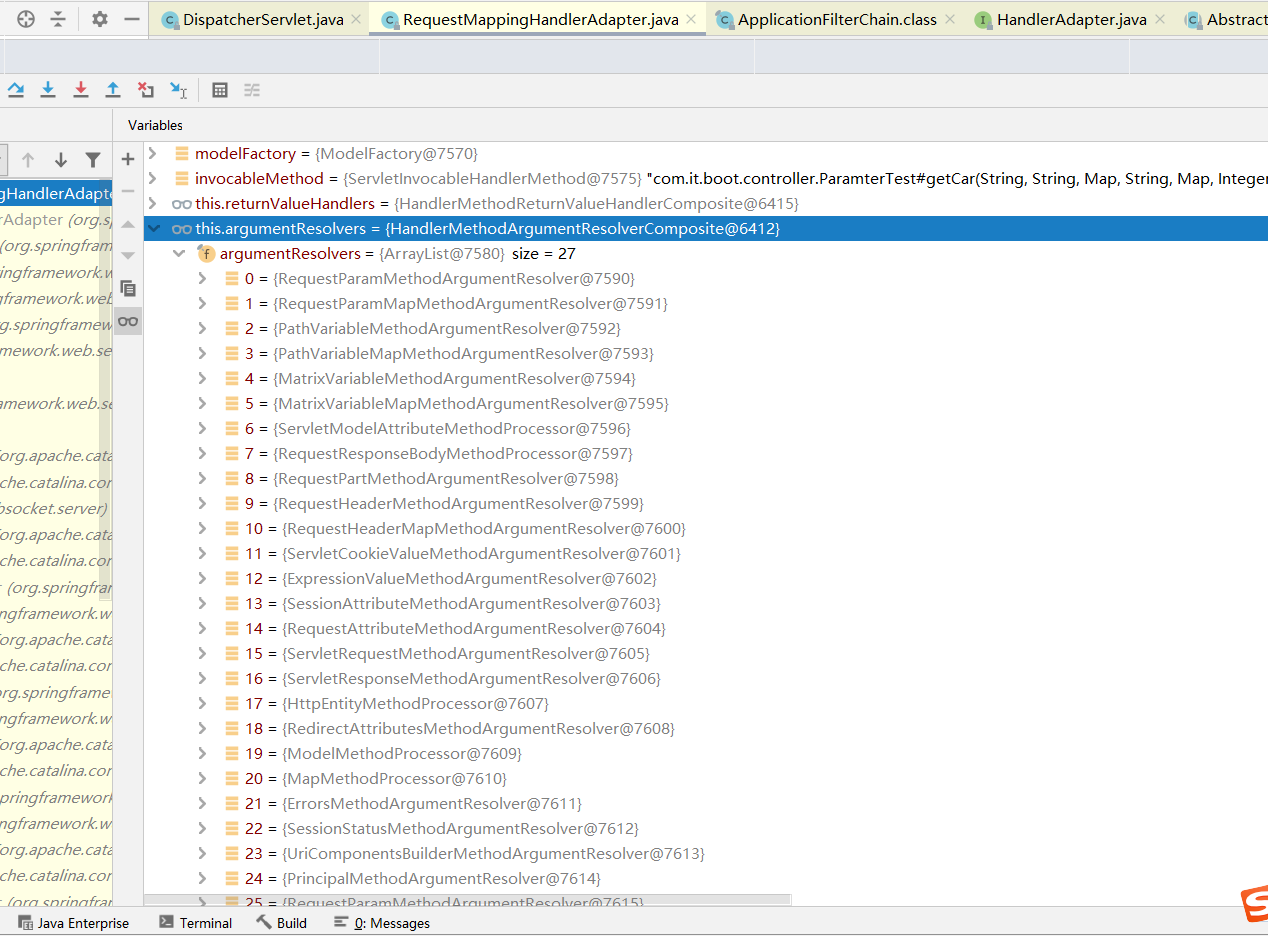

boolean supportsParameter(MethodParameter parameter); Object resolveArgument(MethodParameter parameter, @Nullable ModelAndViewContainer mavContainer, 先判断是否支持该参数类型, 如果支持, 就调用resolveArgument解析方法 。
4.返回值处理器 。
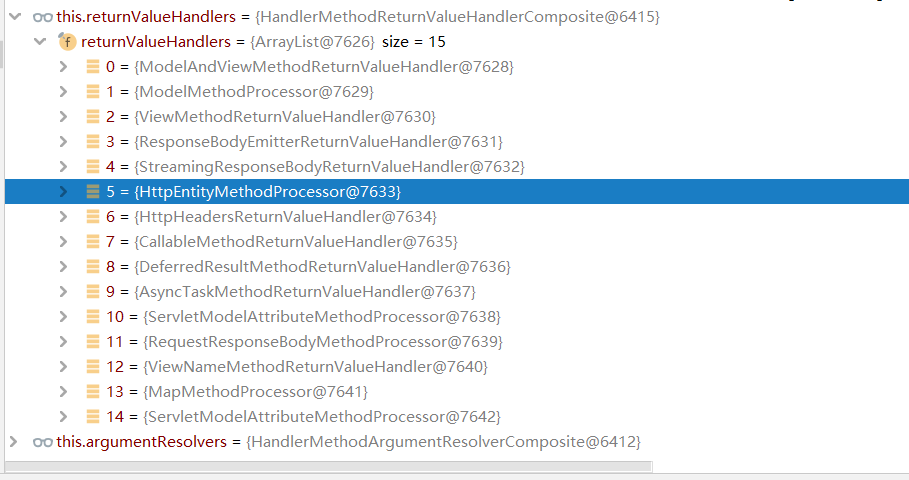
5.挨个判断所有参数解析器哪个支持这个参数:HandlerMethodArgumentResolver: 把控着支持的方法参数类型 。
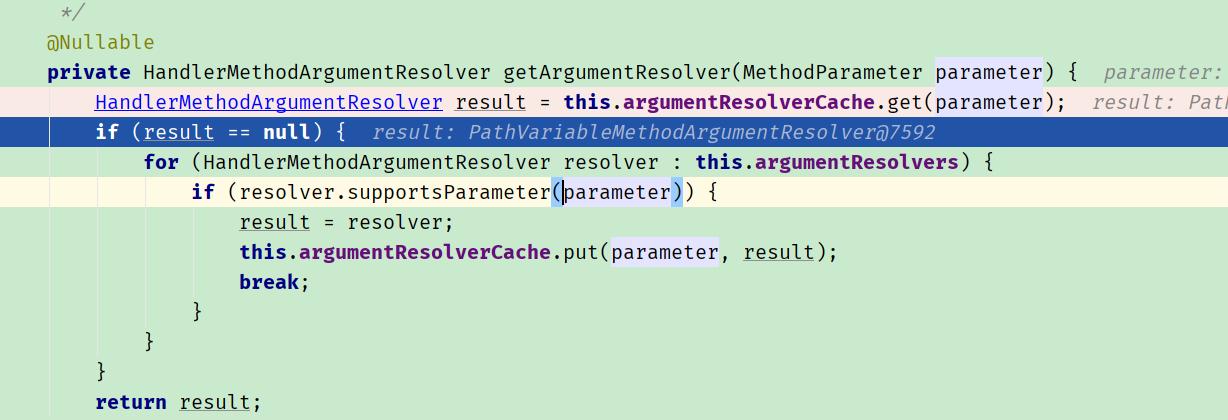
请求进来后, 首先从handlerMapping中查找是否有对应的映射处理, 得到映射适配器Adapter,再通过适配器,查找有哪些方法匹配请求,首先判断方法名,以及参数类型是否匹配,首先获得方法中声明的参数名字, 放到数组里,循环遍历27种解析器判断是否有支持处理对应参数名字类型的解析器,如果有的话,根据名字进行解析参数,根据名字获得域数据中的参数, 循环每个参数名字进行判断, 从而为每个参数进行赋值. 。
对于自定义的POJO类参数: ServletRequestMethodArgumentResolver 这个解析器用来解析: 是通过主要是通过判断是否是简单类型得到的 。
|
1
2
3
4
5
6
7
8
9
10
11
12
13
14
15
16
17
18
19
20
21
22
23
24
25
26
27
28
29
30
31
32
33
34
35
36
37
38
39
40
41
42
43
44
45
46
47
48
49
50
51
52
53
54
55
56
57
58
59
60
61
62
63
64
65
66
67
68
69
70
71
72
73
74
75
76
77
78
79
80
81
82
83
84
85
86
87
|
@Override
public
boolean
supportsParameter(MethodParameter parameter) {
return
(parameter.hasParameterAnnotation(ModelAttribute.
class
) ||
(
this
.annotationNotRequired && !BeanUtils.isSimpleProperty(parameter.getParameterType())));
}
public
static
boolean
isSimpleValueType(Class<?> type) {
return
(Void.
class
!= type &&
void
.
class
!= type &&
(ClassUtils.isPrimitiveOrWrapper(type) ||
Enum.
class
.isAssignableFrom(type) ||
CharSequence.
class
.isAssignableFrom(type) ||
Number.
class
.isAssignableFrom(type) ||
Date.
class
.isAssignableFrom(type) ||
Temporal.
class
.isAssignableFrom(type) ||
URI.
class
== type ||
URL.
class
== type ||
Locale.
class
== type ||
Class.
class
== type));
}
public
final
Object resolveArgument(MethodParameter parameter,
@Nullable
ModelAndViewContainer mavContainer,
NativeWebRequest webRequest,
@Nullable
WebDataBinderFactory binderFactory)
throws
Exception {
Assert.state(mavContainer !=
null
,
"ModelAttributeMethodProcessor requires ModelAndViewContainer"
);
Assert.state(binderFactory !=
null
,
"ModelAttributeMethodProcessor requires WebDataBinderFactory"
);
String name = ModelFactory.getNameForParameter(parameter);
ModelAttribute ann = parameter.getParameterAnnotation(ModelAttribute.
class
);
if
(ann !=
null
) {
mavContainer.setBinding(name, ann.binding());
}
Object attribute =
null
;
BindingResult bindingResult =
null
;
if
(mavContainer.containsAttribute(name)) {
attribute = mavContainer.getModel().get(name);
}
else
{
// Create attribute instance
try
{
attribute = createAttribute(name, parameter, binderFactory, webRequest);
}
catch
(BindException ex) {
if
(isBindExceptionRequired(parameter)) {
// No BindingResult parameter -> fail with BindException
throw
ex;
}
// Otherwise, expose null/empty value and associated BindingResult
if
(parameter.getParameterType() == Optional.
class
) {
attribute = Optional.empty();
}
else
{
attribute = ex.getTarget();
}
bindingResult = ex.getBindingResult();
}
}
if
(bindingResult ==
null
) {
// Bean property binding and validation;
// skipped in case of binding failure on construction.
WebDataBinder binder = binderFactory.createBinder(webRequest, attribute, name);
if
(binder.getTarget() !=
null
) {
if
(!mavContainer.isBindingDisabled(name)) {
bindRequestParameters(binder, webRequest);
}
validateIfApplicable(binder, parameter);
if
(binder.getBindingResult().hasErrors() && isBindExceptionRequired(binder, parameter)) {
throw
new
BindException(binder.getBindingResult());
}
}
// Value type adaptation, also covering java.util.Optional
if
(!parameter.getParameterType().isInstance(attribute)) {
attribute = binder.convertIfNecessary(binder.getTarget(), parameter.getParameterType(), parameter);
}
bindingResult = binder.getBindingResult();
}
// Add resolved attribute and BindingResult at the end of the model
Map<String, Object> bindingResultModel = bindingResult.getModel();
mavContainer.removeAttributes(bindingResultModel);
mavContainer.addAllAttributes(bindingResultModel);
return
attribute;
}
|
WebDataBinder binder =binderFactory.createBinder(webRequest,attribute,name) WebDataBinder:web数据绑定器,将请求参数的值绑定到指定的javaBean里面 WebDataBinder 利用它里面的Converters将请求数据转成指定的数据类型,通过反射一系列操作,再次封装到javabean中 。
GenericConversionService:在设置每一个值的时候,找它里面所有的converter哪个可以将这个数据类型(request带来参数的字符串)转换到指定的类型(javabean—某一个类型) 。
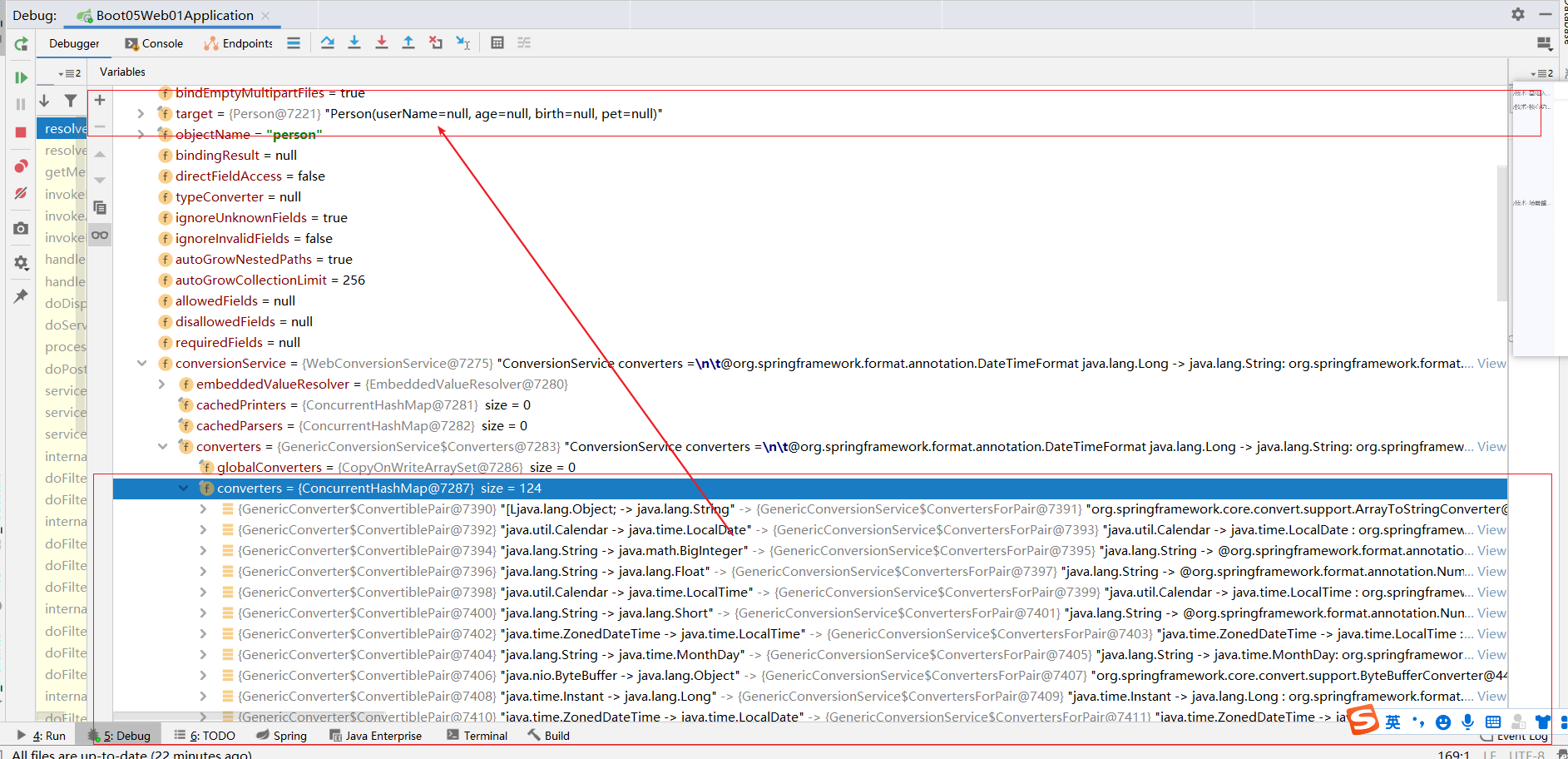

未来我们可以给WebDataBinder里面放自己的Converter 。
|
1
2
3
4
5
|
private
static
final
class
StringToNumber
implements
Converter<String, T> {
converter总接口:
@FunctionalInterface
public
interface
Converter<S, T> {
|
//自定义转换器:实现按照自己的规则给相应对象赋值 。
|
1
2
3
4
5
6
7
8
9
10
11
12
13
14
15
16
17
|
@Override
public
void
addFormatters(FormatterRegistry registry) {
registry.addConverter(
new
Converter<String, Pet>() {
@Override
public
Pet convert(String source) {
if
(!StringUtils.isEmpty(source)){
Pet pet =
new
Pet();
String[] split = source.split(
","
);
pet.setName(split[
0
]);
pet.setAge(split[
1
]);
return
pet;
}
return
null
;
}
});
}
|
Map/Model(map/model里面的数据会被放在request的请求域 相当于request.setAttribute)/Errors/BindingResult/RedirectAttributes(重定向携带数据)/ServletRespons().SessionStaus.UriComponentsBuilder 。
6.在上面第五步目标方法执行完成后: 将所有的数据都放在ModelAdnViewContainer;包含要去的页面地址View,还包含Model数据 。
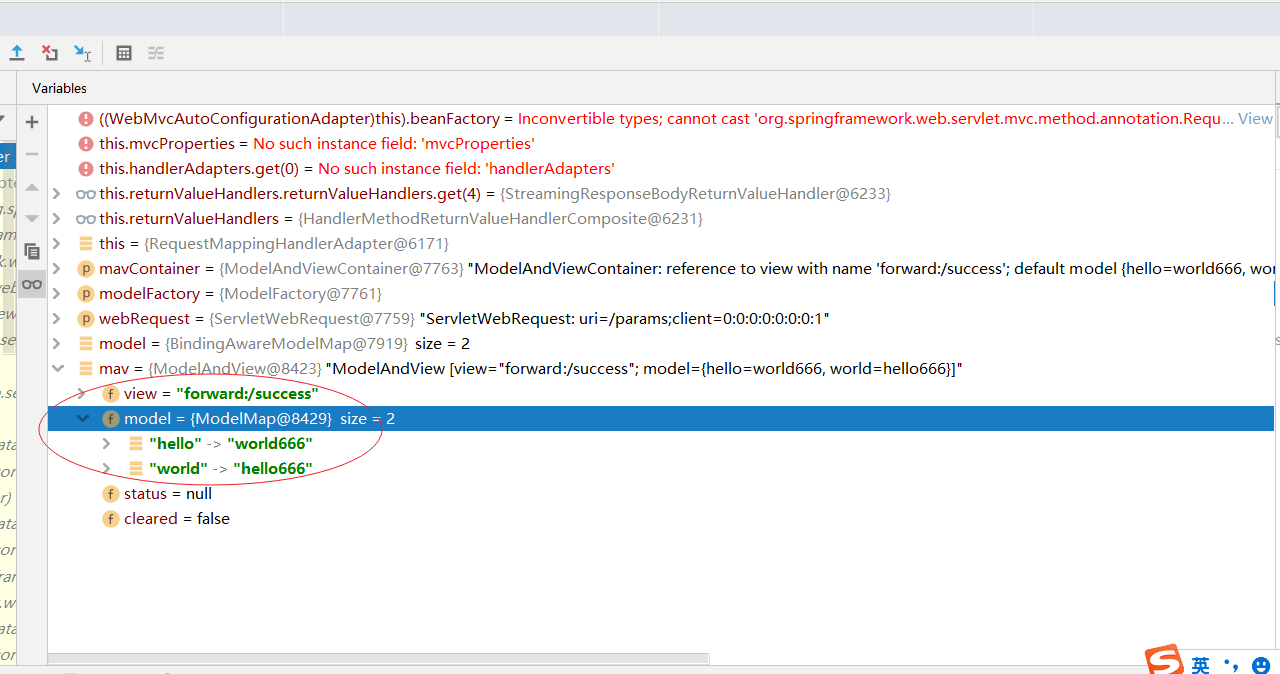
7.处理派发结果 。
processDispatchResult(processedRequest, response, mappedHandler, mv, dispatchException),
在页面进行响应前, 进行视图渲染的时候: exposeModelAsRequestAttributes(model, request); 该方法将model中所有参数都放在请求域数据中 。
|
1
2
3
4
5
6
7
8
9
10
11
12
13
14
15
16
17
18
19
20
21
22
23
24
25
26
27
28
29
30
31
32
33
34
35
36
|
protected
void
renderMergedOutputModel(
Map<String, Object> model, HttpServletRequest request, HttpServletResponse response)
throws
Exception {
// Expose the model object as request attributes.
exposeModelAsRequestAttributes(model, request);
// Expose helpers as request attributes, if any.
exposeHelpers(request);
// Determine the path for the request dispatcher.
String dispatcherPath = prepareForRendering(request, response);
// Obtain a RequestDispatcher for the target resource (typically a JSP).
RequestDispatcher rd = getRequestDispatcher(request, dispatcherPath);
if
(rd ==
null
) {
throw
new
ServletException(
"Could not get RequestDispatcher for ["
+ getUrl() +
"]: Check that the corresponding file exists within your web application archive!"
);
}
// If already included or response already committed, perform include, else forward.
if
(useInclude(request, response)) {
response.setContentType(getContentType());
if
(logger.isDebugEnabled()) {
logger.debug(
"Including ["
+ getUrl() +
"]"
);
}
rd.include(request, response);
}
else
{
// Note: The forwarded resource is supposed to determine the content type itself.
if
(logger.isDebugEnabled()) {
logger.debug(
"Forwarding to ["
+ getUrl() +
"]"
);
}
rd.forward(request, response);
}
}
|
通过循环遍历model中的所有数据放在请求域中 。
|
1
2
3
4
5
6
7
8
9
10
11
12
|
protected
void
exposeModelAsRequestAttributes(Map<String, Object> model,
HttpServletRequest request)
throws
Exception {
model.forEach((name, value) -> {
if
(value !=
null
) {
request.setAttribute(name, value);
}
else
{
request.removeAttribute(name);
}
});
}
|
不管我们在方法形参位置放 Map集合或者Molde 最终在底层源码都是同一个对象在mvcContainer容器中进行保存 。
到此这篇关于SpringBoot与SpringMVC中参数传递的原理的文章就介绍到这了,更多相关SpringBoot SpringMVC参数传递内容请搜索脚本之家以前的文章或继续浏览下面的相关文章希望大家以后多多支持脚本之家! 。
原文链接:https://blog.csdn.net/qmxqing/article/details/119141647 。
最后此篇关于SpringBoot与SpringMVC中参数传递的原理解析的文章就讲到这里了,如果你想了解更多关于SpringBoot与SpringMVC中参数传递的原理解析的内容请搜索CFSDN的文章或继续浏览相关文章,希望大家以后支持我的博客! 。
Github:https://github.com/jjvang/PassIntentDemo 我一直在关注有关按 Intent 传递对象的教程:https://www.javacodegeeks.c
我有一个 View ,其中包含自动生成的 text 类型的 input 框。当我单击“通过电子邮件发送结果”按钮时,代码会将您带到 CalculatedResults Controller 中的 Em
我有一个基本的docker镜像,我将以此为基础构建自己的镜像。我没有基础镜像的Dockerfile。 基本上,基本镜像使用两个--env arg,一个接受其许可证,一个选择在容器中激活哪个框架。我可以
假设我想计算 2^n 的总和,n 范围从 0 到 100。我可以编写以下内容: seq { 0 .. 100 } |> Seq.sumBy ((**) 2I) 但是,这与 (*) 或其他运算符/函数不
我有这个网址: http://www.example.com/get_url.php?ID=100&Link=http://www.test.com/page.php?l=1&m=7 当我打印 $_G
我想将 window.URL.createObjectURL(file) 创建的地址传递给 dancer.js 但我得到 GET blob:http%3A//localhost/b847c5cd-aa
我想知道如何将 typedef 传递给函数。例如: typedef int box[3][3]; box empty, *board[3][3]; 我如何将 board 传递给函数?我
我正在将一些代码从我的 Controller 移动到核心数据应用程序中的模型。 我编写了一个方法,该方法为我定期发出的特定获取请求返回 NSManagedObjectID。 + (NSManagedO
为什么我不能将类型化数组传递到采用 any[] 的函数/构造函数中? typedArray = new MyType[ ... ]; items = new ko.observableArray(ty
我是一名新的 Web 开发人员,正在学习 html5 和 javascript。 我有一个带有“选项卡”的网页,可以使网页的某些部分消失并重新出现。 链接如下: HOME 和 JavaScript 函
我试图将对函数的引用作为参数传递 很难解释 我会写一些伪代码示例 (calling function) function(hello()); function(pass) { if this =
我在尝试调用我正在创建的 C# 项目中的函数时遇到以下错误: System.Runtime.InteropServices.COMException: Operation is not allowed
使用 ksh。尝试重用当前脚本而不修改它,基本上可以归结为如下内容: `expr 5 $1 $2` 如何将乘法命令 (*) 作为参数 $1 传递? 我首先尝试使用“*”,甚至是\*,但没有用。我尝试
我一直在研究“Play for Java”这本书,这本书非常棒。我对 Java 还是很陌生,但我一直在关注这些示例,我有点卡在第 3 章上了。可以在此处找到代码:Play for Java on Gi
我知道 Javascript 中的对象是通过引用复制/传递的。但是函数呢? 当我跳到一些令人困惑的地方时,我正在尝试这段代码。这是代码片段: x = function() { console.log(
我希望能够像这样传递参数: fn(a>=b) or fn(a!=b) 我在 DjangoORM 和 SQLAlchemy 中看到了这种行为,但我不知道如何实现它。 最佳答案 ORM 使用 specia
在我的 Angular 项目中,我最近将 rxjs 升级到版本 6。现在,来自 npm 的模块(在 node_modules 文件夹内)由于一些破坏性更改而失败(旧的进口不再有效)。我为我的代码调整了
这个问题在这里已经有了答案: The issue of * in Command line argument (6 个答案) 关闭 3 年前。 我正在编写一个关于反向波兰表示法的 C 程序,它通过命
$(document).ready(function() { function GetDeals() { alert($(this).attr("id")); } $('.filter
下面是一个例子: 复制代码 代码如下: use strict; #这里是两个数组 my @i =('1','2','3'); my @j =('a','b','c'); &n

我是一名优秀的程序员,十分优秀!